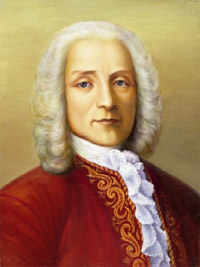Domenico Scarlatti was one of the
ten children of Alessandro Scarlatti, himself a notable opera
composer. Domenico grew up in Naples and by the age of 16 had
become organist and composer at the Neapolitan Royal chapel.
Accompanied by his father, he sought work in Florence before
returning to Naples and composing two Neapolitan operas in 1703
and performing a substantial rewrite of Pollarolo's Irene the
following year.
Scarlatti spent the next four years in Venice, and in 1709 went
directly into the service of Maria Casimira, the exiled Polish
queen then living m Rome. He composed intensively, producing seven
operas for the court, including in 1712 Tetide in Sciro,
one of his 70 surviving operas. In 1713 he was appointed Maestro
di Cappella to the Basilica Giulia in the Vatican, followed the
next year by an appointment to the Portuguese ambassador to the
Vatican, the Marquis de Fontes. This succession of posts allowed
him to expand his interests in both sacred and secular music. Regular weekly recitals under the
auspices of Cardinal Ottoboni, who had already taken Corelli under
his wing, gave him the opportunity to meet Corelli and Thomas
Roseingrave, an Irishman who later helped spread his fame in
England. The Cardinal also introduced Scarlatti to Handel, and
arranged a harpsichord-playing contest between the two.
In 1719 Scarlatti resigned his position. He spent two
years as harpsichordist at the Italian Opera m London, and then
went to Lisbon in Portugal, where he became the Mestre to the
Patriarchal chapel. He made only a handful of return visits to his
native country: one in 1725 to visit his dying father; and another
to Rome in 1728 to marry Maria Gentili, aged 16 and some 27 years
his junior.
Scarlatti finally settled m the employ of the musically gifted
daughter of King John V, the Infanta Maria Barbara, and entered an
extraordinary period of writing. His two 15-volume collections of
sonatas for unaccompanied keyboard, mostly written for the Infanta,
contain more than 500 works and established Scarlatti as one of
the leading composers for the harpsichord. The Iberian influence
is at times evident in these works, revealed in a guitar-like
strumming effect achieved by rapid repetition of notes, and the
sudden shifts from major to minor. These notoriously difficult
pieces require the player to cross hands and play very rapid
scales and arpeggios.
When the Infanta moved to Madrid, Scarlatti with his wife and
five children moved as part of her court, and he eventually became
Maestro de Camara in 1746. Such loyalty to his daughter impressed
Kingjohn, who sponsored Scarlatti in his application to become a
Knight of the Order of Santiago.
Scarlatti's move to the Iberian Peninsula was a significant
event for the development of keyboard music. The Neapolitan style
at that time, based around opera, was very limiting. Scarlatti, by
moving away from this tendency, allowed himself a greater degree
of experimentation and freedom to develop a wholly new form and
style of keyboard composition.
|


No comments:
Post a Comment